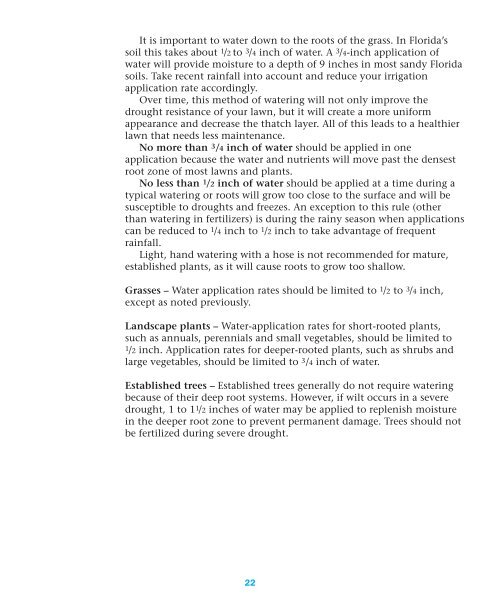What You Need to Know About Fertilizing and Watering - Southwest ...
What You Need to Know About Fertilizing and Watering - Southwest ...
What You Need to Know About Fertilizing and Watering - Southwest ...
Create successful ePaper yourself
Turn your PDF publications into a flip-book with our unique Google optimized e-Paper software.
It is important <strong>to</strong> water down <strong>to</strong> the roots of the grass. In Florida’s<br />
soil this takes about 1 /2 <strong>to</strong> 3 /4 inch of water. A 3 /4-inch application of<br />
water will provide moisture <strong>to</strong> a depth of 9 inches in most s<strong>and</strong>y Florida<br />
soils. Take recent rainfall in<strong>to</strong> account <strong>and</strong> reduce your irrigation<br />
application rate accordingly.<br />
Over time, this method of watering will not only improve the<br />
drought resistance of your lawn, but it will create a more uniform<br />
appearance <strong>and</strong> decrease the thatch layer. All of this leads <strong>to</strong> a healthier<br />
lawn that needs less maintenance.<br />
No more than 3 /4 inch of water should be applied in one<br />
application because the water <strong>and</strong> nutrients will move past the densest<br />
root zone of most lawns <strong>and</strong> plants.<br />
No less than 1 /2 inch of water should be applied at a time during a<br />
typical watering or roots will grow <strong>to</strong>o close <strong>to</strong> the surface <strong>and</strong> will be<br />
susceptible <strong>to</strong> droughts <strong>and</strong> freezes. An exception <strong>to</strong> this rule (other<br />
than watering in fertilizers) is during the rainy season when applications<br />
can be reduced <strong>to</strong> 1 /4 inch <strong>to</strong> 1 /2 inch <strong>to</strong> take advantage of frequent<br />
rainfall.<br />
Light, h<strong>and</strong> watering with a hose is not recommended for mature,<br />
established plants, as it will cause roots <strong>to</strong> grow <strong>to</strong>o shallow.<br />
Grasses – Water application rates should be limited <strong>to</strong> 1 /2 <strong>to</strong> 3 /4 inch,<br />
except as noted previously.<br />
L<strong>and</strong>scape plants – Water-application rates for short-rooted plants,<br />
such as annuals, perennials <strong>and</strong> small vegetables, should be limited <strong>to</strong><br />
1/2 inch. Application rates for deeper-rooted plants, such as shrubs <strong>and</strong><br />
large vegetables, should be limited <strong>to</strong> 3 /4 inch of water.<br />
Established trees – Established trees generally do not require watering<br />
because of their deep root systems. However, if wilt occurs in a severe<br />
drought, 1 <strong>to</strong> 1 1 /2 inches of water may be applied <strong>to</strong> replenish moisture<br />
in the deeper root zone <strong>to</strong> prevent permanent damage. Trees should not<br />
be fertilized during severe drought.<br />
22
















